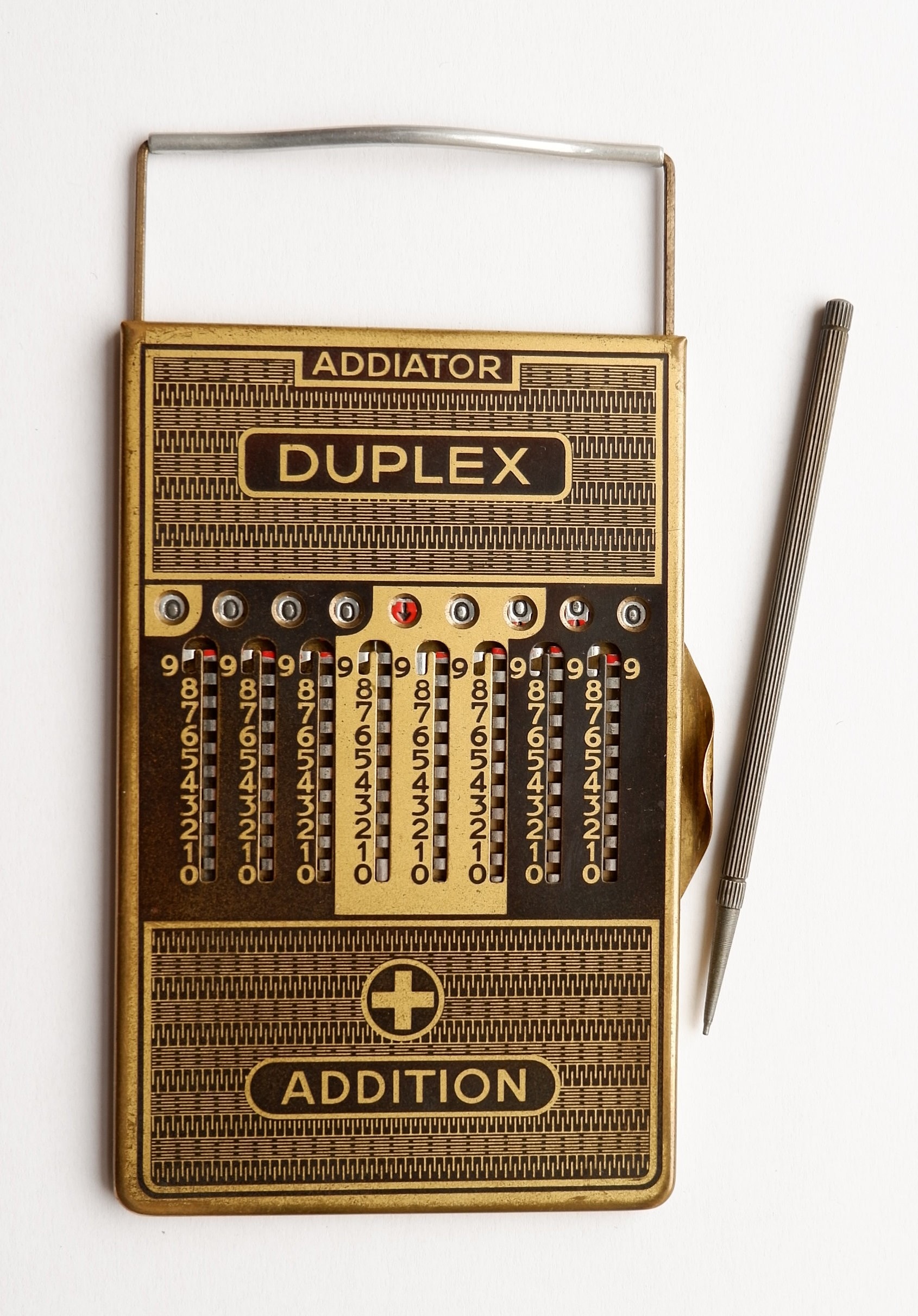Not all mechanical calculators were as sophisticated as the arithmometer or as intuitive as the Comptometer — or as large as either of them. Some, like the addiator, were very simple and very small indeed.

Technically speaking, “addiator” is a trade name often used to refer to a class of small adding machines more properly called slide adders. (They were also sometimes called “Troncets”, after another early manufacturer.) Slide adders comprised a number of parallel, toothed metal strips sandwiched between two boards. Each slide was visible through a slot cut in the board above it — and sometimes the one below it, too, in order to handle subtraction as well as addition. Users moved the sliders up or down in their slots using a stylus, following simple rules to handle carries from one column to the next.1,2,3
For me, the addiator is a fascinating device, and that’s at least partly because I don’t know very much about it. It hovered around the periphery of the more “mainstream”, computer-adjacent calculators that populate Empire of the Sum, but I could never quite make the case to myself that it should be included with them. There were a number of sticking points.
First, setting aside the pioneering idea that an adding machine could fit in a pocket, the addiator was essentially a dead end: neither its internal mechanisms nor its “user interface” seem to have inspired any later devices. As such, very little was written about it at the time.
Equally, despite many modern sources calling the addiator a popular device, there isn’t much data to back up that assertion. The only sales figures I’ve seen suggest that the “Arithma”, a West German model imported to the USA between 1957 and 1973, sold around 2.5 million copies.4 That’s a lot — more than 150 thousand per year — but by way of comparison, Victor, an American firm that made Comptometers and other desktop calculators, churned out twice as many devices in 1968, each one of which would have cost far more than an addiator.5.
Finally, I’m just not sure that I detect the fondness for the addiator that I do for the slide rule or the many different mechanical calculators that came after it. There are many slide rule and calculator collectors; there are far fewer addiator collectors.
And so for Empire at least, the addiator ended up on the cutting room floor. A shame, because this pocketable gadget was nothing if not ingenious in its simplicity.
- 1.
-
Wolff, John. “Slide Adding Machines”. John Wolff’s Web Museum.
- 2.
-
Tout, Nigel. “’Addiator’ Type Calculators”. Vintage Calculators Web Museum. Accessed December 13, 2023.
- 3.
-
Scriven, John. “Addiators”. A Collection of Mechanical Calculators (blog).
- 4.
-
Parsons, F. “Addiator Arithma”. American Stationer (blog).
- 5.
-
Darby, Edwin. It all adds up; the growth of Victor Comptometer Corporation. Chicago: Victor Comptometer Corporation, 1968.
Comment posted by Roger W Turner on
I can’t remember what name they were sold under in the UK, but I think I recall that they were rather too flimsy for real-life use. Very much the opposite of the Comptometer.
Comment posted by Keith Houston on
Nigel Tout is based in the UK — perhaps his page on the subject will have some relevant details?
Comment posted by Banjo on
I picked up a duplex addiator at a thrift store a few years back. It was missing the stylus, but I blunted and old tapestry needle and used that.
It’s actually pretty slick! Because the number remains the same on both the addition and subtraction sides it’s works really well for things like balancing a checkbook or small ledger. And, because the number entry is recessed, you can put it away in your pocket and keep the total “saved”. Its surprisingly quick to use once you get the hang of it… much faster than balancing a checkbook by abacus!
Comment posted by Keith Houston on
Interesting stuff! It took a while before pocket calculators had memory functions, certainly. I’ll have to see if I can lay my hands on an addiator at some point.